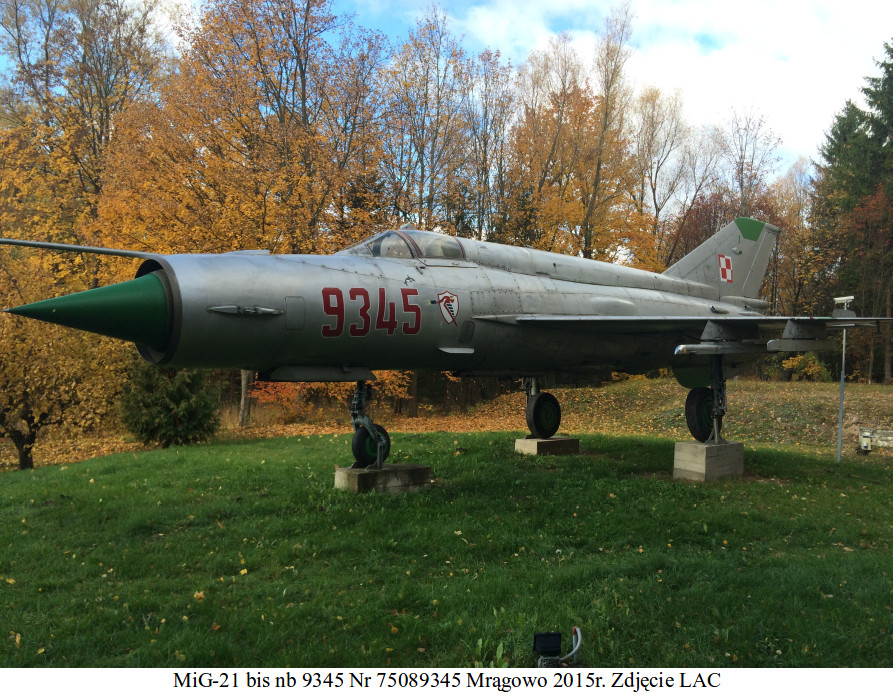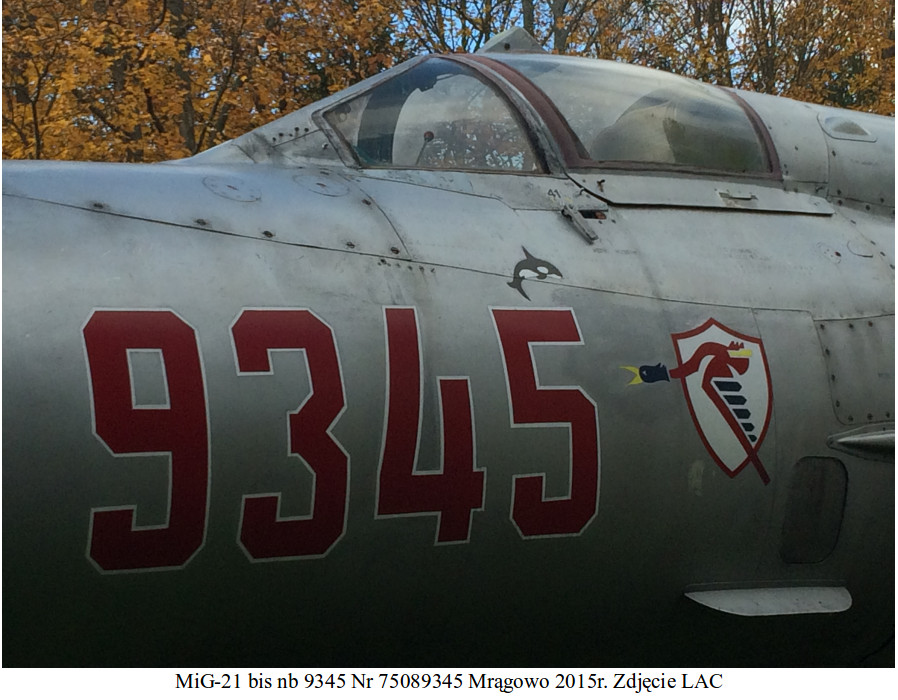Mrągowo 2015-11-10
Two refurbished MiG-21 bis planes in Mrągowo.
MiG-21 bis nb 9345, 8745.
In 2015, in Poland, another two MiG-21 bis planes were renewed and displayed as exhibits that remind us of the rich history of the Polish Military Aviation. These are machines with side numbers 8745 and 9345.

The MiG-21 bis aircraft belongs to the fourth and last generation of MiG-21 fighters. This is a typical representative of the front fighter. Capable of maneuvering at close distances and at low altitudes. From the MiG-21 SM / FM version (third generation), it was distinguished by the engine and the fuel system.
The machine received a new R-25-300 engine with a thrust of 4,020 kG / with an afterburning of 6,960 kG. By design, it received an 8-stage compressor and a second afterburning. It was the range of engine operation known as CZR, from the Russian "czieriezordinaryj rieżim" or extraordinary range. It allows you to activate the second afterburner after switching on the "full afterburn" range. The rotor speed then increases to 102.5%. The result is that the thrust increased to 1 x 9,720 kgf (1 x 9,800 kgf), which is more than the weight of the airplane. This range can only be activated at speeds Ma> 1 and altitudes up to 4,000 m, and it can only run for 3 minutes. The rate of climb increased to 225 m / s, when the MiG-21 F-13 is 150 m / s and the MiG-21 SM is 130 m / s. The acceleration time from 600 km / h to 1,100 km / h was reduced to 19 seconds from 28 seconds. The operational overload increased from 7 g to 8.5 g. Fuel consumption in this range increases enormously, roughly 7.1 liters per second. For this range, a third pump with governor is mounted on the motor. To complete the information, the scope of CZR, when the plane exceeded the altitude of 4,000 m, it turned off by itself without the pilot's participation. The second afterburning was signaled in the cabin by the DOD DOP lamp, and the fire from the engine nozzle was prolonged. Unfortunately, the nature of the new engine must have a lower service life, more complicated and time-consuming maintenance and, unfortunately, higher failure rate. Polish mechanics (at least initially) preferred to use the previous R-11/13 engines. Engines in Poland required greater care and reliability. The R-25 engine could no longer be "twisted onto the wire". Perhaps this opinion was due to the inferior quality of materials, which was the result of the deepening crisis in the CCCP.
The fuel installation was increased to a capacity of 2,885 liters. This effect was achieved by enlarging the overhull tank. The aerodynamics deteriorated, but in a slight and not perceptible way with the new engine. This greater amount of fuel allowed several times (due to the pilot's loss of navigation orientation) to land successfully at an alternate airport.
The aircraft's navigation equipment allowed it to land at a cloud base of 200 m and visibility of 3,000 m, although there were cases of landing at a cloud base of 150 m and visibility of 1,500 m.
The machine was armed with k.p.r. p-p class R-13 M and R-55, and later R-60 M. In a word, the range of weapons has increased. A new radar station (radar sight) has appeared. Theoretically, it entered work after 4 minutes, but practically much faster. The equipment of the cabin is very similar to the MiG-21 MF version.
Why was the MiG-21 bis coupon for Poland?
The Russian state had the MiG-21 bis aircraft on offer since 1975, because they had been assembling them for themselves since 1972. In Poland, the Ministry of National Defense wanted to skip the fourth generation of the MiG-21 and go straight to the MiG-23. This could be done because the 70 years is a period of international relaxation. The potential we had was sufficient. However, the MiG-23 still had design problems. It was about cracks in the welds of the fuel tanks around which the rest of the airframe was built. The armament and the radar station of the MiG-23 MS version was not a significant improvement over the MiG-21 bis. In December 1977, by a decision at the Kremlin, the Warsaw Pact is to withdraw completely MiG-17 (and derivatives) and MiG-21 F-13 fighters and gradually remove MiG-21 PF / PFM fighters from the front line. The Russian offer now includes a new MiG-23 MF plane, much better than the MiG-23 MS. So a decision was made to buy these machines for the 28th PLM OPK Słupsk. But our country was plunging into crisis, and in addition, the Second Cold War began. It is difficult to imagine a possible confrontation between the PZL Lim-5 / 5P and the General Dynamics F-16 aircraft. The export production of the MiG-21 bis was coming to an end. The last pieces were produced for Finland. But it turned out that there were some machines in stock, and possible production would be faster anyway, so it was decided to buy cheaper MiG-21 bis. After Poland, the MiG-21 bis also received Bulgaria. These planes saved us from the purchase of MiG-25 RB reconnaissance and MiG-25 DP interceptors to fight reconnaissance SR-71. In the Warsaw Pact, only Bulgaria purchased the MiG-25.
Shopping for Poland.
One of the most important regiments in Poland were: 28th PLM Słupsk, 26th PLM, and then 9th PLM Zegrze Pomorskie, 34th PLM Babie Doły. MiG-23 planes were bought only for the 28th PLM. For the remaining two, 2 x 36 MiG-21 bis machines were purchased. Thanks to the new planes of the 26th PLM and 34th PLM, they transferred their so far operated machines, mainly the MiG-21 PFM, as a supplement to other fighter regiments.
MiG-21 bis nb 8745 No. 75078745.
The first regiment to be armed with MiG-21 bis planes was the 34th PLM Babie Doły airport. On February 4, 1980, Russian pilots brought the first 10 machines to Poland. They entered service (entered into the stock) on March 6, 1980. Among them was the MiG-21 bis nb 8745 No. 75078745.
The planes were placed on the parking plane near the hangar. Not on the central PPS. There were two committees; from Moscow and Poland from Gdynia and Warsaw. The head of the Polish commission was the commander of the 34th Regiment, Col. Marian Gniady. Each plane was thoroughly checked; cabin equipment, installations and their operation, even tires. Everything was entered into the handover protocol. Comments and omissions were entered and the CCCP website removed them. We must remember that in the history of the Polish Military Aviation there was a case of failure to collect MiG-21 planes from the Russian side due to their serious flaws. The entire procedure took several days.
The plane in the 34th PLM was used until 1994, that is, until the regiment was disbanded. It was then that the plane was handed over to the 41st PLM Malbork. Then the plane went to Mrągowo, to the Military Training and Conditioning Center.
MiG-21 bis nb 9345 No. 75089345.
The retooling of the 26th PLM took place in 1981. The plane brought to Poland, MiG-21 bis nb 9345 No. 75089345, arrived in a group of 18 machines in July 1981. All these planes were entered into the state on July 14, 1981. The planes were delivered by air (flyby). The procedure for handing over the planes at the 26th PLM in Zegrze Pomorskie was the same as the year before in Babie Doły. The Polish commission was headed by the regiment commander, Lt. Col. Bogusław Wasilewski. In 1989, the 26th PLM was renamed the 9th PLM. In fact, the 9th PLM in Debrzno was liquidated, and some of the staff transferred to Zegrze Pomorskie. As a result, the plane was entered into the state of the 9th PLM, although it did not change its homing point.
In 2000, in connection with Poland's accession to NATO, the 9th PLM was transformed into the 9th Tactical Aviation Squadron. The story of the 9th ELT is very short and closes in two years. From December 31, 2000 to November 27, 2002, when the squadron was disbanded. The plane went to the 41st squadron in Malbork. On January 1, 2001, the 41st PLM in Malbork ceased to exist, and in its place the 41st ELT and the 22nd Blot were established. Then the plane went to Mrągowo, to the Military Training and Conditioning Center.
During the combat duty, the Polish MiG-21 bis were usually displayed in such a way that one had 2 x R-3 Rs, and the other 2 x R-60s. Polish pilots have mastered these machines perfectly. During joint exercises with German pilots flying Panavia Tornado planes, it was the Poles who always won duels (!).
At the end of 2003, the use of MiG-21 planes came to an end. Apart from Malbork, the MiG-21 bis also went to the 3rd ELT Krzesin. Not all of them have taken off yet. Their resources have run out. They served as a spare parts warehouse. You need to know that after an appropriate renovation, the planes could be used for almost 20 years, i.e. a total of 40 years. At this point, it is worth mentioning the overhauls and repairs of the MiG-21 bis and R-25 engines. The aircraft underwent the first inspection after 50 hours of flight. Both the engine and the airframe were inspected. After that, the airframe was inspected every 100 hours and the engine every 50 hours. The first engine overhaul was performed after 400 hours. The first repair of the airframe was performed after 800 hours. The second major overhaul was performed after 1,600 hours and the aircraft could fly up to 2,400 hours. Calendar service was also possible, but our machines until 1990, earlier reached the recommended hours. The calendar service talked about a maximum of 20 + -2 years. When our planes left service, they were 22 years old and few of them made 2,400 hours in the air. On average they were approximately 1,600 hours. This was due to the financial limitations of the 90s, when pilots flew less.
During disaster operation, we lost 5 MiG-21 bis machines. Most of the disasters occurred at the time of landing. The last flights on the MiG-21 bis aircraft were made in 3 ELT in Krzesiny on December 16, 2003. The planes were offered for sale. A proposal was made for Romania to rebuild it into the Lancer version. In 1999, 6 MiG-21 bis and 1 MiG-21 UM were sold to Uganda. They all belonged to the 9th PLM. The disassembled machines were loaded onto the An-124 transport deck and taken to Uganda.



Written by Karol Placha Hetman
